I generally eschew high dollar collector cars, the auctions and well-known auto pundits do a pretty thorough job of covering that end of the hobby. I like to lurk around in the more pedestrian side of driver quality cars or maybe even what passes for a wreck that isn’t as done as it initially appears. But when I came across this 1969 Ford Mustang Boss 429, I had zero choice but to dive in and look closer at this holy grail muscle car. It is located in Elk Grove Village, Illinois and available here on eBay for a current bid of $143,820, reserve not yet met.
I can recall when both the Boss 302 and 429 Mustangs were introduced. I preferred the 429 version because of its excessively clean styling and lack of trim as opposed to the busier 302 variant. I had no idea of the significance between the two cars and how the Boss 429 contained no ordinary 429 CI engine as you saw badged on the fender of a Country Squire station wagon. I’m not much of a historian but I can tell you that the entire story around the design and creation of the Boss 429 along with the Kar Kraft connection and NASCAR’s involvement is a fascinating read. We won’t see the likes of an undertaking like that again.
This mustang was owned by its original owner until 1981, and in that twelve years, saw only 13K miles pass beneath its modified shock towers. Since ’81, this Boss has been a garage dweller, accumulating another 30 miles and now it’s for sale. It would seem that both owners knew exactly what they possessed, this was no ordinary Mustang. And examining the images, one can tell this Mustang is in excellent 51-year-old condition, not perfect but in very sound shape. The Wimbleton White finish has nicely aged with a few small nicks but it still has depth and sheen. The minimally adorned body panels hang straight and give no evidence of prior damage. I prefer the body-colored hood scoop on this ’69 example as opposed to the universally black finished scoop as found on the ’70 version. No need to go for Goodyear reproduction Polyglas tires, this Mustang still has its originals, though I would be inclined to limit my motoring and speed on this half-century-old rubber. As is typical, this Boss is equipped with Magnum 500 wheels and there is no sign of thin surface rust invading the chrome rims which seems to happen over time.
The interior of this Ford shows little to no wear though it is rather moldy. The black upholstery fabric, which was the only way the Boss 429 rolled, needs a deep, thorough cleaning but that’s about it. The instrument panel, in particular, looks like new. And a simple, functional instrument panel it is, much preferred to the complex mish-mash often found in more modern cars. As with so many uber, performance cars offered by domestic manufacturers in that halcyon year of 1969, A/C was not an option on the Boss 429 Mustang.
What makes the Boss 429 is its 429 CI, 375 gross HP, V8 engine. Designed for racing modification for NASCAR’s high banks at Daytona or Talledega, this unique motor went the homologation route via the Mustang as opposed to the Torino which was Ford’s primary NASCAR entry. We can debate the horsepower output all-day long and I don’t want to dwell on that aspect of this special engine but it’s not hard to imagine that this big Ford motor was probably underrated. And it makes for an impressive sight with its massive semi-hemi cylinder heads, it is a physically huge engine. Curiously, for such a grade-A muscle car, there is no discussion regarding its operational capability. All Boss 429’s came equipped with a four-speed manual transmission and this example is no different.
This major-domo Mustang is one of 857 produced in ’69 (there were two Mercury Cougars produced with this behemoth engine too). If I have interpreted the Kar Kraft (the firm that made the front-end modifications to accommodate the engine) numbering sequence, this example was the 320th produced. While I’m not a Ford guy, I think this Boss 429 is an absolutely top-flite example of the intersection of domestic performance auto production and motorsports, a bygone era that will not return. Take the motorsports component out of the equation and what’s left is one of the most impressive muscle cars of the time. I’ll never own one, I wouldn’t know what to do with it considering the value (not that I could afford it). I have seen these special cars trade well north of $200K so it’s hard to say where this example will top out. The value has jumped $2,000 while I have been writing this article so we’ll have to keep an eye on it. I know many of our readers bemoan special cars that are hermetically sealed and traded solely on investment value. I’m of that same frame of mind too but I’m afraid that this Boss 429 is destined to stay in investors’ hands, don’t you think?
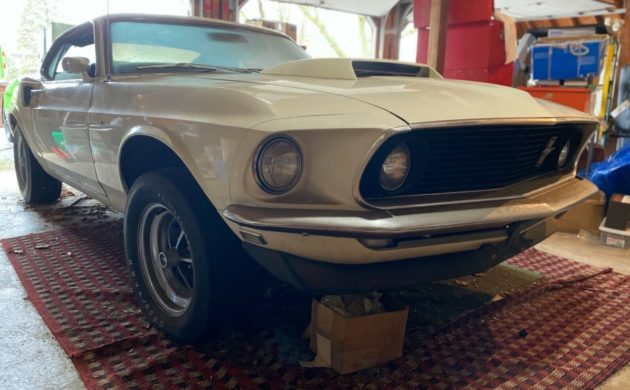
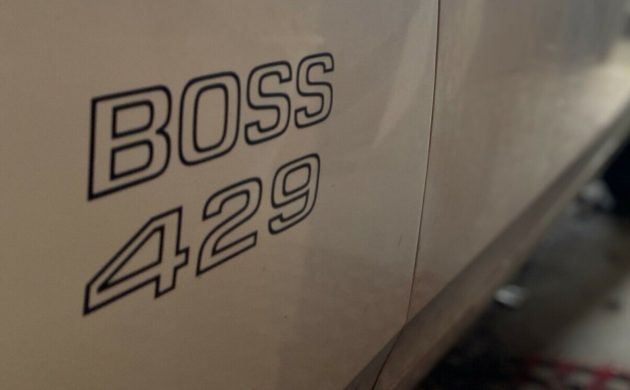
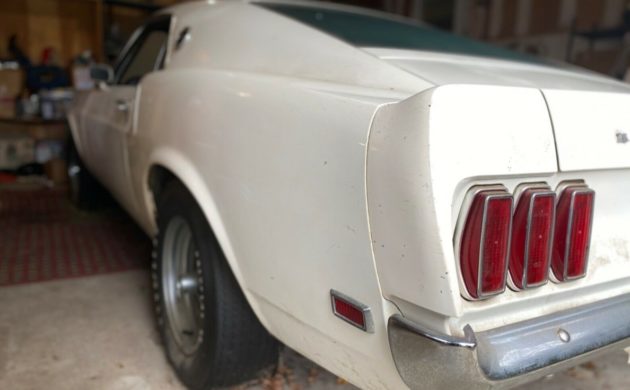
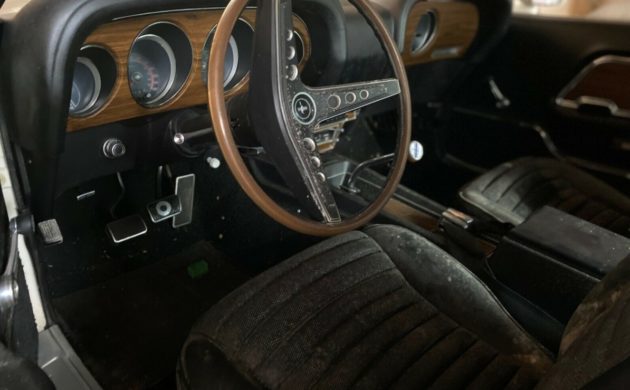
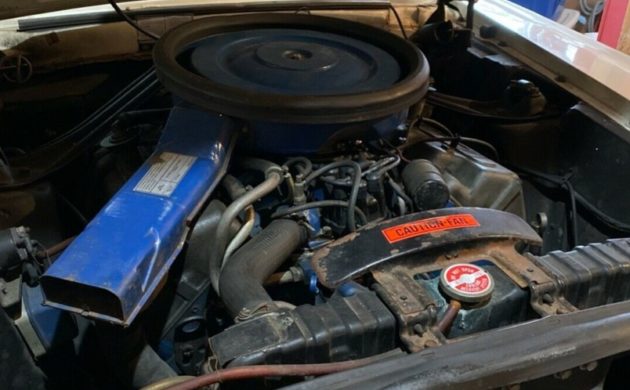
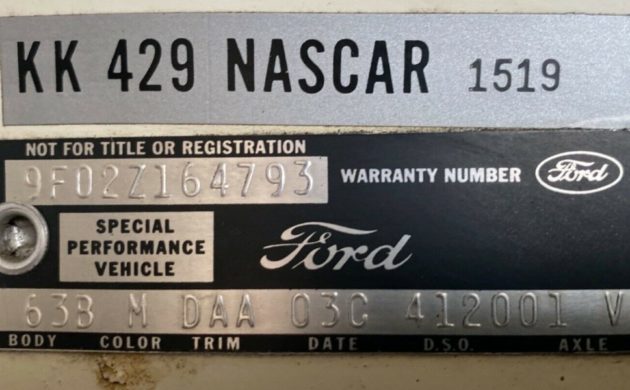


Have to agree that I too will never own one of these cars from an era that will never happen again. These were costly to the manufacturer to build, but it was to sell a brand Sunday and sell a car on Monday. The Boss 429 did nothing well, heavy front end, engine was detuned to run on the street, but it is such a cool car for so many reasons. Oh yeah lift the hood and look at the candy!
holy shnikes!
what a time capsule.
flipping amazing garage find.
super curious about why now is the time to sell but daaaaamn it’s cool
I have owned several Mustangs but none of them had the front end ground clearance this one has. Is it because the front view picture was taken when the engine was out do you think?
Maybe the front end was still on blocks? For an owner who knew what they had, wouldn’t that be the smart thing to do?
I would concur on the ride height. Engine out? That is about where they end up when you pull the motor. Why isn’t the rear off the ground if it is on blocks? Pics do show engine in car though. The factory cars sat almost an inch lower in the front than the standard Mustangs because of the A-arm relocation relative to the standard Mustang. I know these cars well former owner of KK 1634. It will be interesting to see where it ends on the final bid.
Looks like a orange jack stand leg under the left rear axle to me.
I’m curious what you guys think a fair market value for this one would be. I realize there are too many unknowns to be super accurate, but what’s you range as to what you think it’s worth? Seems as though many of the finished ones are going in the 200k and up range.
Not sure, but I bet it is a heck of a lot less then it used to be.
beautiful car indeed!
At one of the auctions, there were 2 of these and they brought in the high $300s if I remember correctly. Had a friend whose dad owned the local ford dealer, had one of these new. One day, he had it out at school, did a burnout in the parking lot and the next thing you saw was a blur then his stoplights at the street. I do remember he had a lot of trouble with oil leaks. The big thing I remember was that there was literally no room for the master cylinder. Love the way Ford was able to cram a big@$$ engine into a little body!!!
Stay safe and wash yer hands
Cheers
GPC
There was no room for the battery either, so it was relocated to the trunk.
The Boss 9 is my lottery car, which means I’ll never own one. 😎
Today’s compact (ex. Walmart Value) batteries might fit under the hood.
I’m thinking there’s less chance of rust/leaks by Ford putting the trunk gasket on the trunk LID instead of on the trunk opening SILL, like the way GM did it.
That’s a big gas cap – did they “go missing” often, like the Gremlin ones?
I don’t think those seats & steering wheel should be that dirty at all, if the car was covered.
The rest of the interior looks lot cleaner.
Maybe someone did a partial cleaning?
Only 24 lb pressure recommedned in the tires? Crazy.
Does the boss have a dual pt distributor?
Always thought this was the coolest and best looking Mustang ever. It looks to be in pretty good shape, although I wish the owner would have cleaned and detailed it and pulled it out of the garage and taken some better pics. If I owned it, I would have to take it out and drive it at least occasionally. No way would it sit idle for 40 years. Will be interesting to see what it goes for.
TRAGIC that ownership for all that time did not care for the car. Actually neglectful in my opinion. Cult car, amazing car… so it is going to sell high and find a new home and get treated right BUT for such an original car…..TERRIBLE that ownership did not take care of the car. It could be SO MUCH BETTER today had someone cared. WOW.
Sorry but that is a rough looking 13K miles under the hood.
For this kind of money I want to see the undercarriage. It’s Illinois folks, I live here and road salt is BRUTAL even to a car like this IF it did not see salt BUT IF the daily driver was parked in the same garage I GUARANTEE YOU it transfers to stored cars. Spent my whole life dealing with rust in Illinois and own and have owned MANY cars.
Driven hard AND put away wet!
MANY MANY MOONS ago when I was I high school the neighborhood Ford dealer always seemed to have a very interesting piece on the showroom floor. One was a Boss 429. AS I recall the engine literarily had to be put in with a shoehorn and I recall the modified shock towers.
In the original Chilton’s 1966-1973 manual there is an entire section that details all of the differences between the Boss 429 and the standard FE version. It’s a fascinating read because it was written for the independent garage owner who just had one of these towed in. The reprinted version of the manual omitted that section. Pretty much the only thing the Boss shared with the FE was the displacement.
The FE had nothing in common with the standard 429 and the BOSS 429, including the displacement. The FE was the 428, 428CJ and 428SCJ of 1968-1970 Mustang model years. There was a 429CJ and 429SCJ in the 1971 Mustang that replaced the FE version.
385 series engine was all new, massive bore with a relatively short stroke (3.52?), my understanding was it was a cleaner running emissions engine, a big quiet running passenger car engine displacing 429 cubes,, later 460, I’ve heard of an oddball sized heavy truck version too, 391 or 366(??)
The Boss 429 super speedway mill was based on the new 385 series and is the first high performance version of that line, although you’d never know they had anything in common by sight. Little time for development unlike the old FE 427 which had been tuned, developed, and torn down and re built to within an inch of perfection for racing. Medium risers, high risers, over head cams, tunnel port heads, everything was tried with success on that 427. Gotta figure most Ford guys knew how to build the FE and most likely had a bunch of extra parts too, none that would interchange with the new 429,, Boss or standard thunder jet.
I always wondered if Ford had tried to develop Boss 302/Cleveland style staggered valve heads for the FE, which were heavy breathers, I mean why not. They tried everything else. Just BSing.
Had me a 69 428 cj and loved the hassle of changing plugs 35 years ago so I’m buying another one but a big block Cougar. Boss prices are a dream for me at this point.
Ah, Dave the Boss had nothing in common with a FE engine not even displacement, Boss 429 were built of the newer 385 series,429,460, Boss 429 and there was a can-am all aluminum version displacing 494 cid. If these motors had had a longer life span ( built from factory for only two years ) for more R&D they would have truly given the Chrysler Hemi a run for it’s money. As for performance all that was needed was a carb and cam change and it was a low 12 sec. car.
Oh man, she’s a cherry of a car! My absolute favorite car of all time. Tougher looking than the Mach 1 and a Boss 302, it’s all business with the straight up paint, simple block letters and numbers decal, and a real hood scoop. Just the sight of that Boss ‘9 engine in person startled me,,,sort of breath taking.
I’ve only seen one in person that I can remember, like the song says, “just one look….that’s all it took yeah”.
Treat her right.
Not too knowledgable on Ford’s special vehicles.
I never knew that this was a track only car.
Probably a smart move.
Not really a “track only” car, that would be the LO23 Hemi Darts and the 1964 Thunderbolts. This car was meant, like the Talledegas, Daytonas, and SuperBirds to meet NASCAR homologation requirements. Back then, NASCAR wanted the fans in the stands to be able to buy a car just like the ones that won last Sunday.
The question that maybe someone can answer is why Ford didn’t put the Boss in the Torino or Cyclone models that were actually racing the Grand Nationals at the time.
Today, if you can find a good Torino, you can build a Boss 429 Talladega in your garage.
I had a strange dream a few years ago…walking through an abandoned warehouse I came across a crate containing a NOS Boss 429 with an automatic transmission bolted to it. That would be a rare piece indeed.
I am aware of the homologation requirements. Thanks to that, we ended up with many great cars – one my favorites, the AAR Cuda include.
What causes me to think it is track only is the “Not For Title Or Registration” printed on the info plate.
Did the Superbirds, Daytonas, etc also have that printed on them? I would think that would make it impossible to register for the street.
The Mustang was Fords high profile “sporty” car, maybe not the best idea really as they lost thousands of dollars on each one sold, but that’s the only logical reason I’ve ever heard.
No track car here as you stated, actually a difficult task at hand for Ford to get that deep breather to run on the street. Got hammered by the journalists back then .,,,,.for being no quicker than the cheaper 428 CJ.
SuperBirds and Daytonas were intended for street use, like the Buick Grand Nationals, Chevy Monte Carlo SS and Pontiac 2+2 that would come later. I never knew that these Mustangs had that restriction on them.
And I may be wrong, but isn’t the plate the door sill plate? The registration numbers would come from the dashboard VIN plate?
I think I finally get it.
The “Not For Title Or Registration” refers to the number below it – it’s not a VIN.
That nomenclature is not limited to the Boss 429’s, all the Ford / Mercury door data tags say this. The door tag was not to be used for Title or Registration ~ it was a factory data tag, to be used for dealer warranty information only.
Title and Registration info was supposed to come from the dash tag.
Gee, no one noticed the odometer.. oh well… that’s a hard ride for the miles..
There was no restriction on the B429. Total street legal car with warranty.
Also door tag needs to match the VIN on the dash.
Knudsen made the call on the B429 going into the Mustang. They would get the best play from a marketing perspective using the Mustang vs. the Torino / Spoiler. Plus the fastback style in ’69 was epic relative to the other platforms from a styling perspective.
The other comment regarding the Hemi vs. B429. The Hemi out of the box for street use got the nod as far as performance went. However, the B429 had a slight advantage on the track on the Cup circuit. Ford even got Petty to join the fray in ’69. The Winged cars changed all that in ’70, but Ford dominated cup in ’69. Also B429 street engines were not true hemi head motors as the chamber was a crescent shape vs a hemispherical shape, but the B429 Cup motors were full Hemi.
The street motors needed headers more than anything. A bigger carb would help, but Cam was necessary to bring it to life. Ford provided a late ’69 Tech bulletin outlining the cam upgrade that became available on the 1970 model production run. A COPO Camaro would smoke a stock B429. So would an LS6 Chevelle and Hemi car. You had to massage a B429 a bit to make it work but once you installed the day 2 upgrades it was tough to beat. KK#1634 is a day 2 car and it ran hard at least when I owned it. I hope the new owner is keeping it in tune
Thanks Skibum2, for the odometer observation. I thought I was the only one that
realized – and pointed out on numerous occasions – that if the numbers don’t line up, the odometer has been wound back. Apparently that’s not a problem for folks interested in this car since all the other aspects of it make the value through the roof anyway. For reasons beyond my comprehension.
But, for folks who want a low mileage auto and willing to pay extra for that, they need to learn to look at, and understand, the odometer as functioned before electronic speedos.
Man, if this is what it says it is,,,,,,it would take a lot of discipline to hardly drive it. How do you do that ?
Ill bet its great in a straight line, and flys every which way on curves.
Also, it has a lot of mold on the seats and dash……..hmmmm……….and looks like the trunk rubber was reglued……or was it built on a Friday?
Nah, that’s pretty much how the factory slopped the glue for the seals. Probably see a bunch of it around the door seals too.
I bet the reserve is north of $375,000. Nineteen Eighty-One was a long time ago. A very long time for an engine to sit without releasing the valve springs. In 1981 new cars had carburetors, cable TV was breaking new ground, most telephones were made by The Bell System as AT&T had yet to be broken up. Henry Ford II was still the head of Ford and the Compact Disc or CD’s was first shown to the public, not sold but shown. Most cell phones were big flat boxes that were bolted under car seats. Sitting for 41 years with none of the fluids changed is not a good thing to do. The owner could have driven it around the block once a month all this time and he would have a very low mileage car that starts up and runs. It would be worth a lot more today.
I have only seen one of these on the street. It is the only Ford I had respect for. I am a Chevy guy. The 428 Super Cobra Jets where okay too. I street raced every day back in the early seventies. I ran small block & big block Chevy’s. 390 Mustangs were sooo slow!!! A good 289 could out run one.
Well, it didn’t meet whatever reserve the owner (second) had on it. Ended @ $205,044.00. As a former (ordered new) BOSS 351 owner, I was interested in both these and the BOSS 302s. The only one I saw regularly street driven in Chicago was a Blue one owned by the owner of an Auto Body shop on Western Ave, just North of Devon Ave. He kept it pristine. Saw him driving it on local streets and he’d park it outside his shop on the sidewalk. Great advertising !
I also read all the reviews car mags re: the stock street version & how NASCAR got “swayed” by Chrysler corp to handcuff these and flat prohibit the SOHC 427 Ford from competing…gotta love racing politics !
1969 boss 429 was litterally was not a cool car. half hour in slow traffic floorboard was so hot you could not keep your feet on the pedals and if you had to sit through a second redlight for left turn engine over heated.
in reallity, the coolest car i ever had
i was about to go 440-6pack cuda when i saw bos9 on show room floor.
bought it thought it woulld wringle the road up behind me but with big engine up front, i thought i would have to start slowing down half a block before making a turn. i was wrong in all the right places since i was an old go-kart racer and street racer. from the factory it was not the fastest but close. i got killed by a couple 440-6-packs but that no shame. the boss out handled any american production car except maybe a corvett. a few months old my go-kart blood kicked in. went to a scca single car at a timed event in a large parking lot road coarse set up with traffic pylons. one car at a time ran on the clock. everything still factory, boss came second, first place was a well prepared firebird. 427 cobra (another class and in the wrong hands) was slower. for stopping big disks on the front where big engine weight is and first american factory car to have 60-series tires, one car magazine tested more than 1-g deceleration during braking. the boss was not for drag racing but intended to continually high power at the high end like nascar racing but to day ford stil makesl semi-hemis (boss type) complete engines in the 489 ci range that found their place at best truck pulling contest like tractor pulling.
in 1969 i street raced (out on county roads, big deal, many onlookers) a freshly tunned hemi plymouth roadrunner. hemi vs hemi. mustang was to light on rear wheels so roadrunner pulled boss by a fender out of the hole. by the end of 3rd gear boss caught even bumper to bumper (aprox 80 mph) when in 4th gear (remember boss for high end) the BOSS walked ahead by a full car length by the end.
problems: boss spark plugs were new style and speacial. ford dealers only at first and five times the price.
frequent tune ups necessary until installed electronic ignition fixed that.
biggest problem was detinination, only one gas was good enough “sunnoco 360” very expensive (39 cents per gallon in the day).
the back spark plug on driver side was pain in the rear until found the wright two 1/4 in extensions and u-joint to change plug.
all in all the coolest car i ever owned BOSS 429
many times i wished i was born with one leg backwards so i could kick my self in the ass for not keeping it.
Just looked up the last time, it was recent, a Boss 429 was auctioned: Barrett Jackson, car sold at $462,000.00! I also saw a Boss 429 engine, rebuilt, for sale for $30,000.